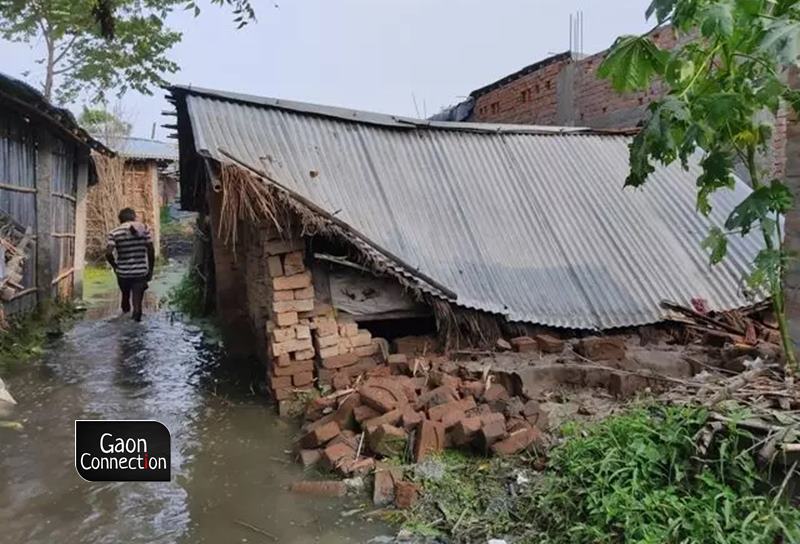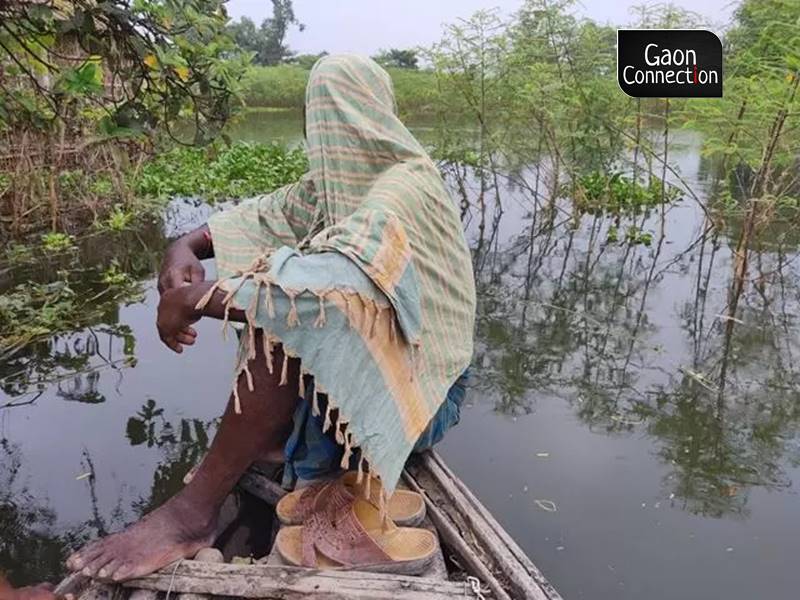Endless cycle of displacement leaves villagers in Bihar in a flood of misery
Seventeen out of Bihar’s 38 districts are reeling under the impact of floods. Forced to abandon their water-logged homes, people in Katihar and Bhagalpur districts are living in makeshift shelters that are sometimes no more than a polythene sheet over their heads. Several of these villagers have been displaced multiple-times by the floods in the past.


Floods have been plaguing Bihar since June and so far 43 lives have been lost.
The annual phenomenon of floods in Bihar forces villagers into a game of musical chairs as they move around looking for a dry and safe patch of land, till the next wave of flood displaces them, forcing them to move again.
Manju Devi and her family are, sadly, a part of this endless cycle of displacement and despair in India’s most flood-prone state. About 25 years ago, in the 1996 floods, her village Malainiya, in Katihar district of Bihar was eroded by the floodwaters of Ganga River, and Manju Devi lost her home and land. Ever since, she and her family have been on the move. And this year’s floods have displaced them yet again.
“The waters of the Ganga and the Kosi rivers flooded my home about a fortnight ago, and I had to leave everything and flee,” Manju Devi told Gaon Connection, pointing to the water marks on the kuchcha walls of her home that clearly indicate the level to which the waters had risen.

Manju Devi and hundreds of others like her are now living dangerously close to the railway tracks near her village Malainiya in Kursela block of Katihar, about 250 kms away from the state capital Patna. They eat and sleep under tarpaulins and plastic sheets and have access to neither proper drinking water nor toilets.
When the floods of 1996 eroded their village, Manju Devi and her fellow villagers set up kuchcha homes on railway land, near their village. They claim they have neither received any compensation nor alternative land to build their houses. Year after year, floodwaters have been entering their homes forcing them to be constantly on the move.
This year’s floods have pushed them to the edge of railway tracks, where everyday is a challenge not to get run over by high speed trains.
Of the 38 districts of Bihar, 17 districts, including Meena Devi’s Katihar district, are in the grip of severe flooding. According to the daily flood report (August 30) issued by the state’s disaster management department, about 3.2 million people from 525 panchayats were affected by the floods. Of these, more than 200,000 were moved to safety into shelter homes.
Floods have been plaguing Bihar since June and so far 43 lives have been lost due to that. While in some areas the floodwaters are receding, because of the waters being released from neighbouring Nepal and from the Balmiki Barrage and Birpur in the state, as well as relentless rains, the problems will continue, say the people.
“The water began to flood the area around my house about a month and a half ago. It seeped into the drums where I had stored about seven quintals of maize. I had also planted radishes and ladies’ fingers on a small patch of land, and they rotted too under all that water,” Manju Devi complained. Her house will become liveable only after Dussehra (mid-October), she said, adding she had spent Rs 80,000 on its repairs just last year.

Floods, filth and fear
“We have to defecate outdoors as there are no toilets, and for women this is a problem,” 48-year-old Chinta Devi from Kursela, told Gaon Connection. Even for drinking water, she said, they had to go to the railway station.
“Our temporary homes, next to the railway tracks, are surrounded by filth,” the 48-year-old complained. Instances of diarrhoea, fever and other ailments are common. And, there are no signs of any move by the authorities to keep the area clean by way of spraying bleach, Chinta Devi said.
The displaced people living near the railway tracks are never far from danger. “My sister visited me on Raksha Bandhan and when she was returning home, she was run over by a train,” Sadanand Sharma, told Gaon Connection, grief stricken. The fear of trains is never far away. “There is always one adult who is charged with ensuring the children do not stray onto the way of the trains,” said one of the inhabitants of the area.
Displaced villagers said they had received little or no help from the government. “There has been no financial help whatsoever. Political leaders come, observe and go, that is all. There is no help forthcoming,” Muso Mandal, one of the displaced flood-victims, told Gaon Connection.
Manju Devi added: “All we received as help from the government were polythene sheets and food that we are served at a government school, and even that is not every day.”.

“The community kitchens that are set up here cook a lot less than what is required to feed so many people,” a local people’s representative, on condition of anonymity, told Gaon Connection. For many of the flood affected people, reaching the community kitchens is also a struggle.
Meanwhile, flood-hit villagers neither have any work, nor any income, but have loans to repay.
Manju Devi said she had borrowed a lakh (Rs 100,000) from a self-help group and she had no idea how she would repay it. “I am being pressured to repay the amount, but the floods have left me with nothing to eat, where will I find the money to repay my loan,” she lamented. Her husband 50-year-old Manik Lal Mandal who worked as a daily wage labourer in Kursela market is also without a job.
SOPs being followed
While villagers complain there has been no help from the government, Ajay Kumar, Block Development Officer (BDO), Kursola, Katihar, told Gaon Connection: “Standard operating procedures are being followed in all wards that are flood hit and community kitchens have been set up there. “He dismissed the complaints of insufficient food and no help as baseless.
According to Ajay Kumar, flood relief funds had been released, arrangements had been made for drinking water at community centres, and wherever necessary, hand pumps have been set up by the Public Health and Engineering Department.
According to the state government, 327 community kitchens have been set up in the flood affected areas. Also, there are 17 teams from the National Disaster Response Force (NDRF) and 12 teams from the State Disaster Response Force (SDRF) that were stationed there to help.
Also Read: IMD warns of flash floods in Bihar’s Pashchim Champaran; entire villages evacuated
No sign of help in Bhagalpur
Despite being just 500 metres away from the Rangra Block Office, in flood-affected Bhagalpur district, people out of their own initiative and with no help from the authorities are setting up a hand pump. Inhabitants of the Rangra village say the government has not even provided them with polythene sheets.
“Some officials from the district headquarters did come a couple of days ago, but they returned as there was too much water everywhere,” one of the village inhabitants told Gaon Connection.
Also Read: Bihar floods: An annual blame game between India and Nepal
“The public has neither received rations, nor polythene from the authorities. We do not even have fodder for our cattle,” Om Prakash Mandal, a 41-year-old inhabitant of Rangra, told Gaon Connection. “All our crops were destroyed in the floods. The government should at least provide compensation to the farmers who lost everything,” Om Prakash said. The farmers here are not even aware of crop insurance, he added (Bihar does not implement the Pradhan Mantri Fasal Bima Yojana).
“We had asked for more than five thousand polythene sheets, but we received only one thousand five hundred and thirty sheets that we distributed. But in a few days an amount of six thousand rupees will be credited to the accounts of the flood affected,” Ashish Kumar, circle officer of Rangra, told Gaon Connection.
Meanwhile, just behind the office of the circle officer, is a basti where people’s homes are still waist deep in water, and they have received no help yet from the authorities.
Also Read: Known predominantly for droughts, why are districts in south Bihar facing floods?
Thirty-year-old Pappu Mandal and his 21-year-old wife Lakshmi Devi, who live in this basti, became parents to a baby girl on August 19. The baby was born in a government hospital. Though the state government had announced that if a baby girl was born to a flood affected family, they would receive Rs 15,000 and if it was a boy, the parents would receive Rs 10,000.
“The hospital refused to give us any money saying only if the pregnant mother came to the hospital in a boat would she get the amount. There was no boat available to us,” Pappu Mandal told Gaon Connection.
Ashish Kumar, the circle officer who was aware of this, assured the new parents that it was a mistake and the money would soon be given to them.
Read the story in Hindi.

